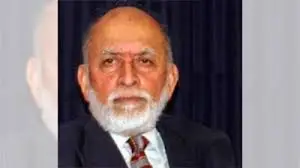Veteran nuclear scientist M R Srinivasan passes away at 95

May 20, 2025 – Ooty, Tamil Nadu: India has lost one of its most respected and pioneering scientists, Dr. Malur Ramasamy Srinivasan, who passed away peacefully at the age of 95. Known widely as a key architect of India’s nuclear energy program, Dr. Srinivasan’s contributions have been instrumental in shaping the country’s atomic energy landscape and advancing its pursuit of clean and sustainable energy.
Early Life and Education
Born in 1930 in Bengaluru, Karnataka, Dr. M. R. Srinivasan showed an early aptitude for science and engineering. He completed his undergraduate studies in Mechanical Engineering at Visvesvaraya College of Engineering. Driven by a passion for advanced research, he pursued higher studies in Canada, earning a Ph.D. in Mechanical Engineering from McGill University. His academic journey reflected a profound dedication to mastering the scientific knowledge that would later benefit India’s nuclear ambitions.
Joining India’s Atomic Energy Program
Returning to India in 1955, Dr. Srinivasan joined the Department of Atomic Energy (DAE), where he began working alongside Dr. Homi J. Bhabha, widely regarded as the father of India’s atomic energy program. Together, they played a critical role in bringing India’s first nuclear reactor, Apsara, to operational status in 1956. Apsara became Asia’s first nuclear reactor, marking the country’s official entry into the atomic age.
Leadership in Nuclear Development
Throughout his illustrious career, Dr. Srinivasan held many pivotal positions within the DAE. He contributed significantly to the establishment of major nuclear power plants, such as the Tarapur Atomic Power Station and the Madras Atomic Power Station. These plants were milestones in India’s journey towards energy self-sufficiency, reducing the country’s reliance on fossil fuels and helping diversify the energy portfolio.
In 1987, Dr. Srinivasan was appointed as Chairman of the Atomic Energy Commission and simultaneously served as Secretary of the Department of Atomic Energy. That same year, he founded the Nuclear Power Corporation of India Limited (NPCIL). Under his leadership, India’s nuclear power capacity expanded rapidly, with 18 reactors either operational or in various stages of construction by the time he retired.
Contributions on the Global Stage
Dr. Srinivasan’s influence extended beyond India’s borders. From 1990 to 1992, he worked as a senior advisor to the International Atomic Energy Agency (IAEA) in Vienna. His expertise contributed to the global dialogue on nuclear safety, non-proliferation, and the peaceful uses of atomic energy. His work helped bridge scientific innovation with international cooperation, elevating India’s stature in the world nuclear community.
National Service and Legacy
Beyond his scientific achievements, Dr. Srinivasan played an active role in India’s national development. He was a member of the Planning Commission during the 1990s, focusing on energy and science-related policy-making. Additionally, he contributed to the National Security Advisory Board, where his insights helped guide the country’s strategic planning.
Recognized for his exemplary service, Dr. Srinivasan received numerous prestigious awards, including:
- Padma Shri (1984)
- Padma Bhushan (1990)
- Padma Vibhushan (2015)
- Homi Bhabha Lifetime Achievement Award
- Several honors from scientific and engineering institutions
These awards reflected the nation’s deep appreciation for his dedication and pioneering spirit.
Mentorship and Leadership
Dr. Srinivasan was known not only for his technical brilliance but also for his humility and mentorship. He was a guiding force for many young scientists who later became leaders in their fields. Colleagues describe him as a patient teacher and visionary leader who emphasized teamwork, innovation, and long-term thinking.
He remained committed to advancing nuclear science even after his formal retirement. Through lectures, writings, and advisory roles, he continued to influence policy and research, always advocating for clean, safe, and sustainable nuclear energy.
National Tributes and Mourning
News of Dr. Srinivasan’s passing was met with sorrow and respect across India. Prime Minister Narendra Modi paid tribute, calling him a “towering figure in Indian science and technology” whose work laid the foundation for India’s energy security. Tamil Nadu Chief Minister M. K. Stalin described him as a “true nation-builder” whose legacy would inspire generations to come.
The scientific community also mourned the loss of a stalwart who dedicated his life to the progress of India and the global nuclear fraternity.
Continuing the Vision for Nuclear Energy
Dr. M. R. Srinivasan’s passing is a significant loss for the scientific world and the nation, but his vision endures. As India intensifies its focus on sustainable energy solutions, the path he helped forge will continue to guide future developments in nuclear technology.
His legacy highlights the importance of innovation, perseverance, and dedication in the face of complex challenges. Future scientists and policymakers will build on his groundwork to ensure India’s energy independence and environmental sustainability.
Personal Life and Final Days
Dr. Srinivasan spent his final years in Udhagamandalam (Ooty), Tamil Nadu, surrounded by family and close friends. He is survived by his wife and daughter, who remember him as a humble man with a profound passion for science and service.






